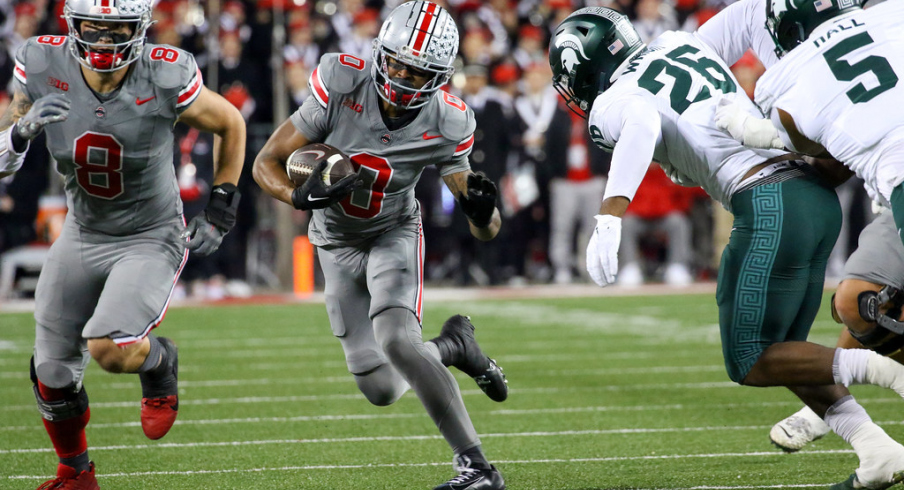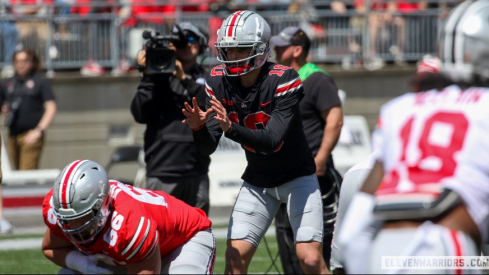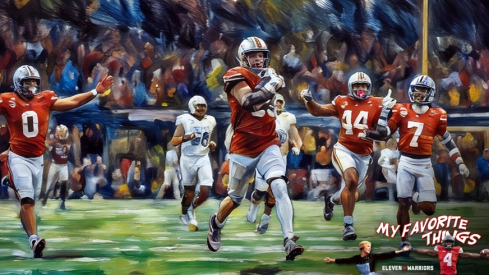Few would blame even the most ardent of Ohio State fans for believing that Ryan Day begins and ends each week's game-planning meeting with the question, 'How do we get the ball to #18 as much as possible?' And, for all I know, that may actually be the case.
Marvin Harrison Jr. is proving to be one of the greatest receivers to ever play college football and has (at least) two more games to make a very legitimate case to be only the fifth wideout to win the Heisman Trophy. While Ryan Day and the rest of the Ohio State football staff have made his case anytime they step in front of a microphone or open social media, Harrison continues to rack up receiving yards, surpassing the century mark seven times already this season.
His latest effort, a 7-catch, 149-yard performance was the basis for arguably the Buckeyes' best offensive performance of the season. The team clad in head-to-toe Gray found the end zone on five of its six first-half possessions before letting backups play much of the second half with the game already on ice.
Harrison was responsible for three of those five scores, but this was not a game plan designed to force the ball to the star receiver.
"You can't do that," Day said of creating a game plan designed to help Harrison's Heisman chances. "I know that that's going to be part of the conversation, but that award is for the most outstanding player, not the player with the most stats. ... We try not to focus on that, we try to figure out what gives us the best opportunity to move the ball down the field."
It certainly appeared that no matter what plays were called from the OSU sideline, success was imminent thanks to the talents of Harrison, Kyle McCord, Cade Stover, TreVeyon Henderson, and an offensive line that has rounded into form.
Upon further review, however, it appears the much-maligned 2023 OSU offense didn't just spam their star player with touches and hope for the best. Rather, it executed a balanced, complementary attack designed to both put its most dangerous players in positions to succeed while also taking what was given to them by putting defenders in conflict.
For instance, getting blockers up to the second-level linebackers has been a challenge for the offensive line all season when trying to run the ball. So, instead of simply hoping things would change in the 10th game of the season, the OSU coaching staff schemed up ways to neutralize those defenders via other means.
On the game's first play, the Buckeyes shifted Stover from one side to the other before motioning Emeka Egbuka in the same direction just before the snap. After what looked like a 3x1 formation to the offense's right suddenly had three receivers on the left, the MSU linebackers were forced to shift accordingly just as the ball was put in play.
When TreVeyon Henderson took a handoff on a Mid-Zone play aiming for the outside hip of the right guard, there was no one was there to even touch him until he was four yards past the line of scrimmage, giving the Buckeyes an easy gain.
With Mel Tucker no longer calling the shots in East Lansing, the Spartan defense has dialed back its schematic complexity this season. Knowing as much, Day continued to pick on those linebackers throughout the game with motions and options that put them in lose/lose situations.
When the Spartans employed two-deep coverage, those linebackers were responsible for Stover in pass coverage when he lined up as an attached tight end. Knowing this, an 'Arrow Screen' concept was added as a 'relief' to the same Mid-Zone run seen above, allowing McCord to read the linebacker responsible for Stover.
If that defender reacted to the run blocking and stayed inside to fill his assigned gap, McCord simply flipped the ball out to the edge where Stover could run behind two receivers setting blocks for him.
But after struggling to consistently execute a single run concept early in the season, the Buckeyes have shown in recent weeks that not only have they gotten much better at running zone schemes, but they're now a very good Counter team as well. Though they continue to rely more on zone-blocking, they've called Counter roughly a quarter of the time since Big Ten play began.
In this 'gap' concept, of course, the running back takes one step in one direction before pivoting back the other way to take a handoff. Those extra steps provide enough time for two pulling blockers to lead him around the end while the rest of the line blocks down, pinning their defenders inside.
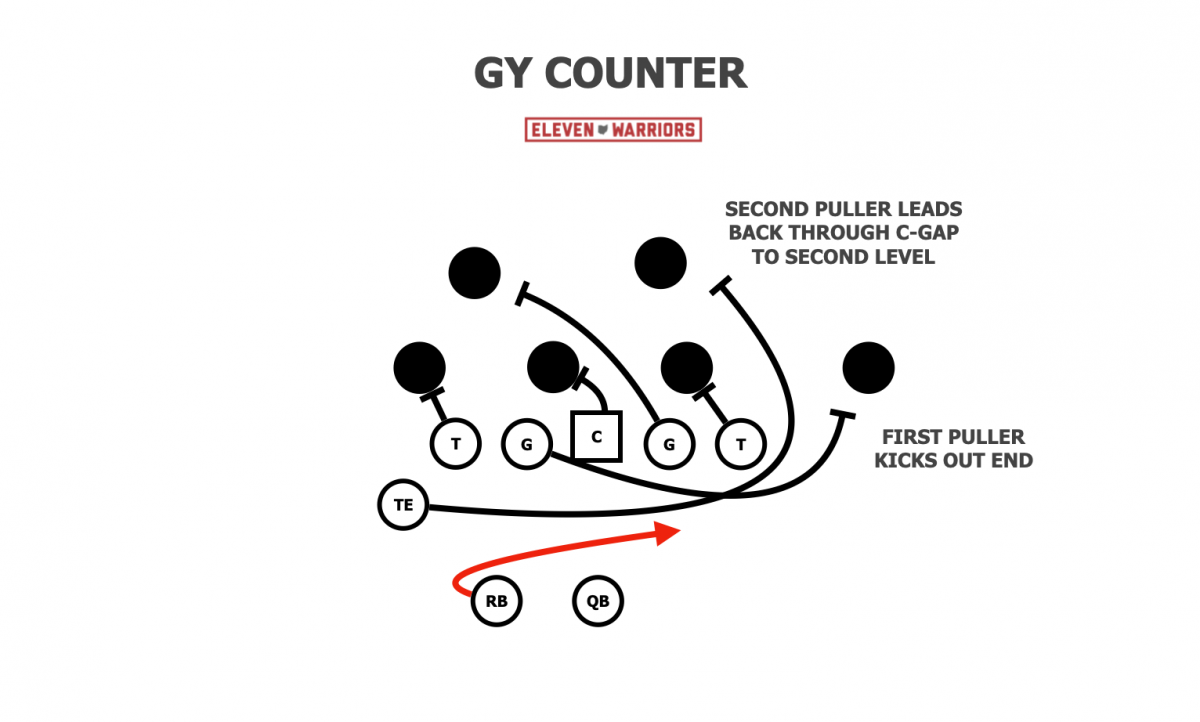
While there are a number of variations of Counter, which can include any combination of the center, guard, tackle, or tight end pulling from the backside, the Buckeyes seem to prefer sending the guard and tight end across the formation as lead blockers.
That down blocking is an important element to call out, as it looks at first like the same, lateral steps the line would take on a mid-zone run going the other way, making Counter a perfect complement to zone blocking. As such, opposing linebackers often look for those two pullers from the backside, stepping up quickly to play the run as soon as they're recognized.
But Day and Co. know the opposition has been keying on these runs more often in recent weeks. After running the concept early in the first drive, Day quickly dialed up constraints to keep the defense honest as the Buckeyes worked down the field while the scoreboard remained blank.
As the Buckeyes approached the Red Zone, they unveiled a seven-man pass protection scheme that initially mirrors the same pullers as GY Counter, with the backside guard and tight end initially moving laterally before settling as interior pass protectors. Those few steps were enough to pull the Spartan linebackers forward, thinking they were about to defend another handoff, only to see McCord drop back and find Stover darting to the sideline behind a linebacker (#27) struggling to get back into zone coverage.
On the very next play, the Buckeyes appeared to block Counter once more, only to see Harrison, of all people, take a reverse in the opposite direction. After taking two steps to his left, tight end Gee Scott Jr quickly changed course and turned into a lead blocker for the Heisman candidate, sealing the edge against an overmatched cornerback.
Roughly 18 hours later, the nation would see this same concept in action again, as San Francisco head coach Kyle Shanahan (considered the best play-caller in the sport) incorporated this same wrinkle when running Counter with Christian McCaffery. Instead of pounding the star running back into a brick wall of defenders over and over, the 49ers incorporated the same reverse off GY Counter action with their best receiver, the electric Deebo Samuel, taking the handoff.
WELCOME BACK DEEBO
— NFL (@NFL) November 12, 2023
: #SFvsJAX on FOX
: Stream on #NFLPlus https://t.co/kECSNGc6Bj pic.twitter.com/YDmvNOdMqd
But Day wasn't done scheming up packages of complementary play calls after the first drive.
With Egbuka returning from an ankle injury, Xavier Johnson's touches have diminished along with his playing time. But after making numerous plays over the past two seasons, the senior captain was still given opportunities to shine in his second-to-last appearance in Ohio Stadium.
Rather than line up in the slot as usual, the versatile Johnson was brought into the backfield in a 2-back set, as he and Chip Trayanum flanked McCord on either side of a shotgun set. Though the Spartans saw 11 personnel (1 running back, 1 tight end) come onto the field, the Buckeyes turned it into 21 (2 running backs, 1 tight end) with Johnson playing the role of the tailback while Trayanum acted as his fullback.
Once again, the Buckeyes would call for the same blocking scheme up front, pulling the backside guard and tight end on a GY Counter play, albeit this time with Trayanum acting as an additional lead blocker.
Just as they'd done with the Counter from their base personnel, the Buckeyes had a complementary package of plays built off that run concept for this personnel set as well.
One of the most successful such wrinkles utilized the same protection scheme off Counter seen above, with the tight end and guard initially appearing to pull before settling inside as pass protectors. This time, however, Johnson appeared to be the lead blocker for Trayanum, only to accelerate downfield on a wheel route that broke for a 31-yard gain.
The linebacker responsible for Johnson in pass coverage (#7) initially bit on the run fake and was caught chasing the much faster receiver out of the backfield.
"He's a mismatch in a lot of different areas," Day said of Johnson and the package designed to get him the ball. "And that's our job as coaches, to put him in those situations."
But the play broke for such big yardage after the catch because of Harrison's presence. The superstar receiver had proven uncoverable in typical man or zone coverage throughout the first half, forcing the Spartans to employ more and more double-coverage.
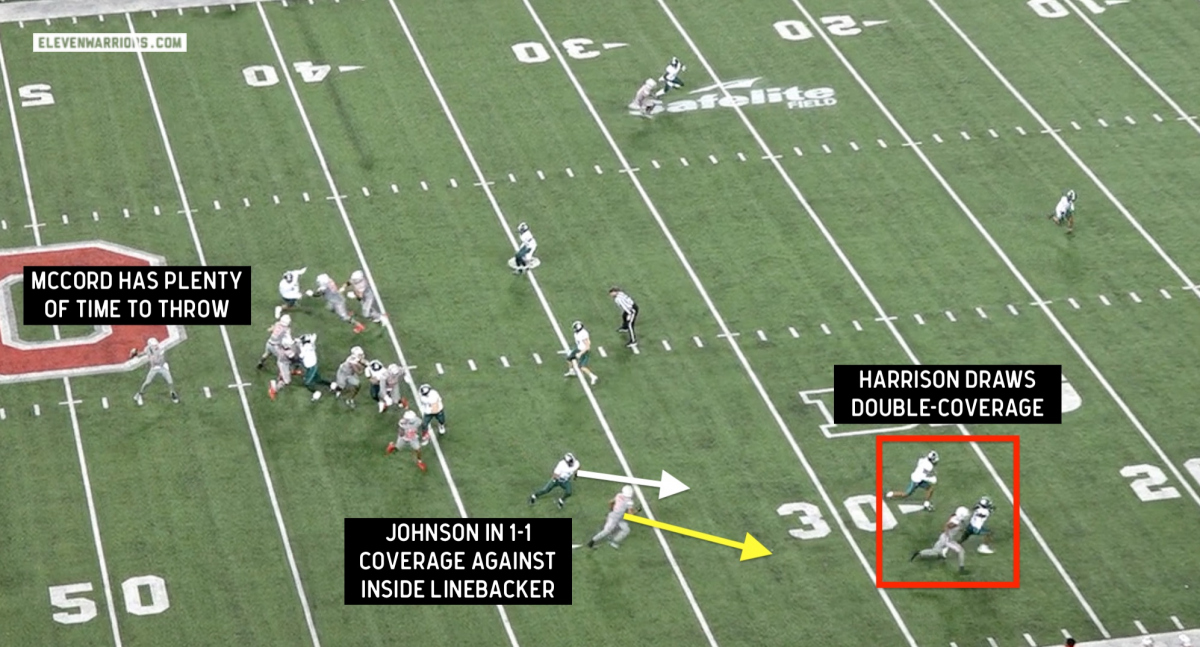
That double-coverage meant that once Johnson broke past his defender in man-coverage, there was no one nearby with eyes on the ball to bring down the electric ball carrier downfield, resulting in an additional 15 yards picked up after the catch.
Day noted as much after the game, noting "there were times tonight when (Harrison) was double-covered, but he still made the play."
Without question, the most important member of Ryan Day's staff in this contest was Mark Pantoni, as the personnel director assembled a squad of players against whom Michigan State was simply no match. But the Buckeyes didn't just brute force their way to a later season win.
Rather, Day and his coaching staff showed that they have found ways to minimize the offense's relative weaknesses while building off its strengths through creative play-calls, much as they've done in years past. As it enters the most pivotal stretch of the season, this unit certainly appears to be hitting its stride.
